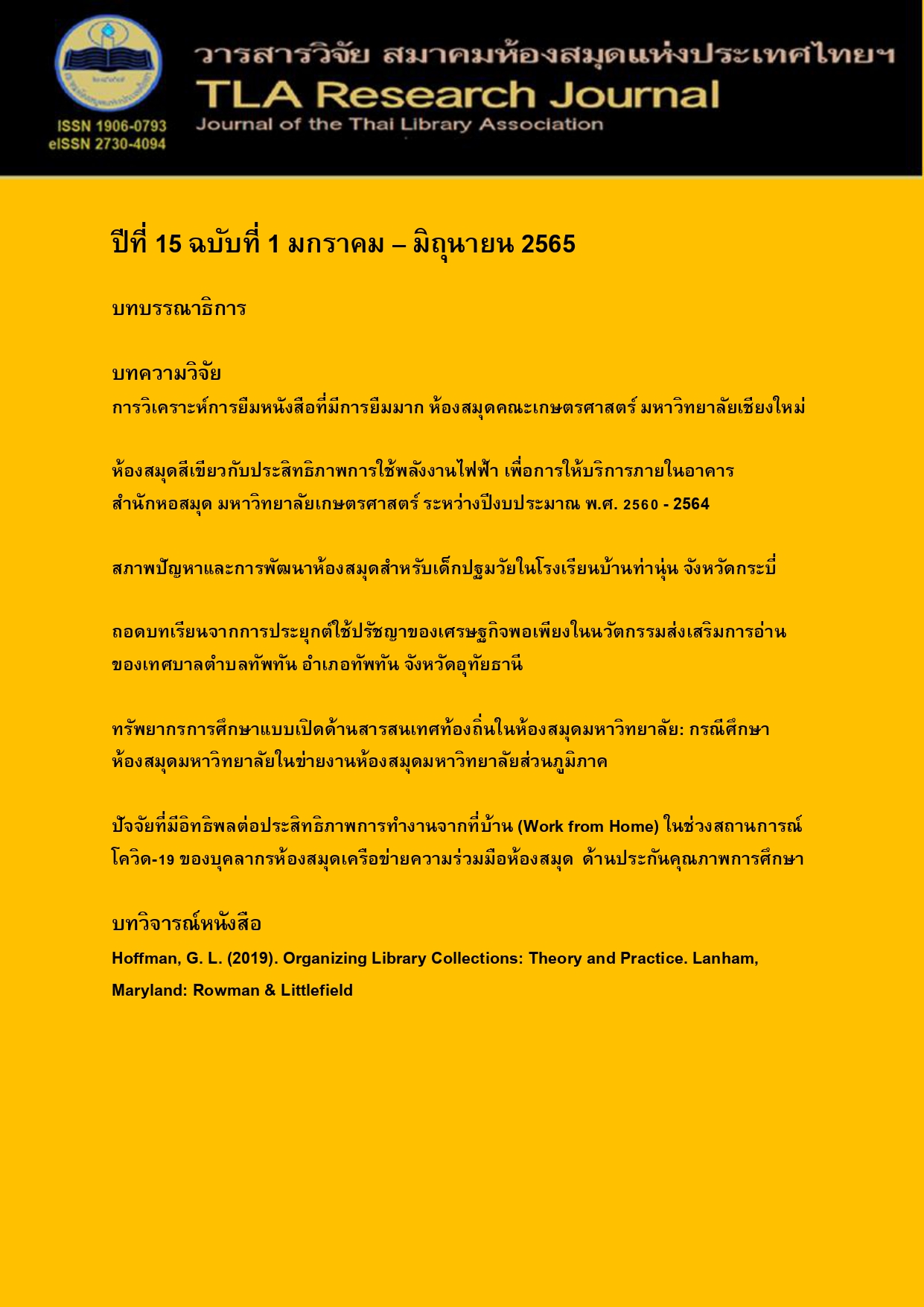Analysis of the Proportion and Frequency of Borrowed Books from the Faculty of Agriculture’s Library, Chiang Mai University
Main Article Content
Abstract
This study aims 1) to analyze the frequency of books, borrowed from the Faculty of Agriculture’s library in Chiang Mai University based on the borrowing rates and books’ call numbers; 2) to analyze the proportion and frequency of borrowed books as it pertained to the curriculum, and based on the data extracted from the library’s automation system; and finally 3) to draft strategies and to design development plans for information resources for the Faculty of Agriculture’s library. The study was conducted by analyzing the frequency of textbooks borrowed from the library using the information available from the library’s automation system between 2010 and 2019. The research revealed that on average Thai books were borrowed and used more frequently when compared to foreign books. However, foreign textbooks appeared to have had higher borrowing frequency when utilized for practical and more specific purposes as compared to Thai general textbooks. Furthermore, the results of the study, based on the textbooks’ call numbers, revealed that both Thai and foreign books were borrowed more than one time with the highest borrowing frequency being associated with the 600 category (Applied Science & Technology) and the 630 subcategory relating to Agriculture, respectively. In addition, the outcomes of the study pointed to the fact that two departments, namely: Horticulture & Animal and Aquatic Sciences, appeared to have been the most frequent users of both Thai and foreign textbooks. Thus, it is critical that the library considers the users’ needs as well as the frequency and types of borrowed resources when purchasing new textbooks. Finally, the findings and information from this study shall be included in the information resources for development plans of the Faculty of Agriculture’s library at Chiang Mai University in order to serve the needs of the patrons and to further promote the efficiency of the library’s budget management.
Article Details

This work is licensed under a Creative Commons Attribution-NonCommercial-NoDerivatives 4.0 International License.
บทความทุกเรื่องที่ลงตีพิมพ์จะได้รับการตรวจอ่านโดยผู้ทรงคุณวุฒิ ความคิดเห็นและบทความที่ปรากฏในวารสารนี้ เป็นของผู้เขียนซึ่งมิใช่เป็นความคิดเห็นของคณะผู้จัดทำ และมิใช่ความรับผิดชอบของสมาคมห้องสมุดแห่งประเทศไทยฯ การนำบทความในวารสารนี้ไปตีพิมพ์ซ้ำต้องได้รับอนุญาตจากคณะผู้จัดทำ
All articles submitted for publication will be reviewed by the academic reviewers. The editorial board and TLA claim no responsibility for the content or opinions expressed by the authors of individual articles or columns in this journal. Reprinting of any articles in this journal must be permitted by the editorial board.
References
Bravo, B. R., Díez, M. L. A., Almuzara, L. B., & Suárez, M. A. M. (2008). Patterns of Use of Electronic Journals in Spanish University Libraries. Serials Review, 34(2), 115-128.
Chansuvarn, W. (2020). Significant Figure.Retrieved from https://web.rmutp.ac.th/woravith/?page_id=2993.[In Thai]
Chiang Mai UniversityDepartment of Library and Information Science. (2006). Access to information resources and writing reports / Department of Library and Information Science Chiang Mai University (Rev. 11 ed.).Chiang Mai: Chiang Mai University. [In Thai]
Danielson, R. (2012). A dual approach to assessing collection development and acquisitions for academic libraries. Library Collections, Acquisitions, & Technical Services, 36(3-4), 84-96.
Hughes, M. (2016). A Long-Term Study of Collection Use Based on Detailed Library of Congress Classification, a Statistical Tool for Collection Management Decisions. Collection Management, 41(3), 152-167.
Kankonsue, O. (2014). Relationships between book collection and circulation at the faculty of Agriculture Library and the Curriculums of Bachelor's Degree of Sciences in Agriculture, Chiang Mai University. Chiang Mai: Graduate School Chiang Mai University. [In Thai]
Kankonsue, T. (2014). Assessment on book collections from circulation statistics at Chiang Mai University Library. Chiang Mai: Graduate School Chiang Mai University. [In Thai]
Kankonsue, T. (2019). Circulation Stats Increasing with Long Tail Marketing Theory. Pulinet Journal, 6(1), 26-37. [In Thai]
Nalamphun, R., Teerawat, N., & Thongkloy, S. (2016). Development of cultural electronic information resources system in Thailand. Chiang Mai: Faculty of Humanities Chiang Mai University. [In Thai]
Ochola, J. N. (2002). Use of Circulation Statistics and Interlibrary Loan Data in Collection Management. Collection Management, 27(1), 1-13.
Sukhothai Thammathirat Open UniversitySchool of Liberal Arts. (2011). Information resources development (First ed. (Rev. 2 ed.)). Nonthaburi: Sukhothai Thammathirat Open University. [In Thai]
Trueswell, R. W. (1964). User behavioral patterns and requirements and their effect on the possible applications of data processing and computer techniques in a university library. Evanston: Northwestern University.
Trueswell, R. W. (1966). Determining the optimal number of volumes for a library’s core collection. Libri, 16(1), 49–60.
Wilson, T. D. (2006). On user studies and information needs. Journal of documentation, 62(6), 658-670.
Wongjamras, P. (2003). Information resource development Teaching Documents Course Process 009230.Chiang Mai: Department of Library and Information Science Chiang Mai University. [In Thai]


